Cascadia Research and the Wild Whale Research Foundation are undertaking a joint field project off the island of Hawai‘i in July and August, 2010. The research team includes Jessica Aschettino and Robin Baird of Cascadia, Dan McSweeney of the Wild Whale Research Foundation, and a number of volunteers. Our primary goals for this project are to obtain photos and genetic samples from the resident (“insular”) population of false killer whales and the resident population of melon-headed whales, but we will also be working with other species of odontocetes we encounter, photo-identifying individuals and collecting samples for genetics and toxicology studies.
For more information see our Hawai‘i odontocete research page
Sign up to our Facebook page if you want to receive updates from future projects.
The most recent updates are at the top of the page
End of project update
August 21st was our last day on the water for this project. Since we started on July 17th we spent 30 days on the water, covering 3,296 kilometers of trackline, and had 78 sightings of 12 species of odontocetes. We took over 45,000 photos (including photogrammetry photos of about 180 individuals of 7 species), collected 33 biopsy samples, 3 prey samples (from false killer whales), 5 squid, 2 sloughed skin samples, 1 mucous sample, and acoustic recordings from both melon-headed whales and false killer whales. A good month. We’ll be back in the field in October, with a project off the island of O‘ahu.
August 19th update
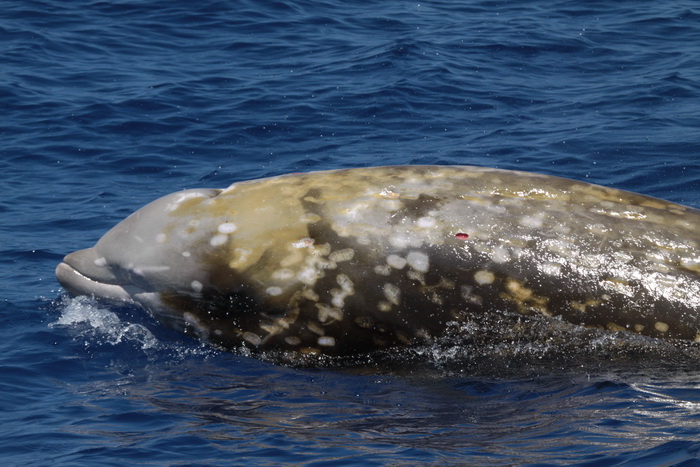
An adult female Cuvier’s beaked whale, August 19, 2010. Photo by Jessica Aschettino. We are able to identify this individual as an adult based on the large number of white oval scars caused by cookie-cutter shark bites (note the one fresh bite that is still red), which accumulate slowly over the years. Based on our photo-identification work these scars remain visible for 10 years or more (see our beaked whale page for more information). If this was a male erupted teeth would be visible at the tip of the lower jaw.

An adult female Cuvier’s beaked whale, August 19, 2010. Photo by Dan McSweeney. We use the cookie-cutter scars, dorsal fin shape, and linear scars (from interacting with males) to identify individuals. This individual is HIZc018 in our catalog, first identified off the island on September 27, 2002. On that date we tagged this individual with a suction-cup attached VHF tag and tracked her for 7 hours, the first time a Cuvier’s beaked whale had ever been tagged, documenting the extremely long dives (her longest was 87 minutes).
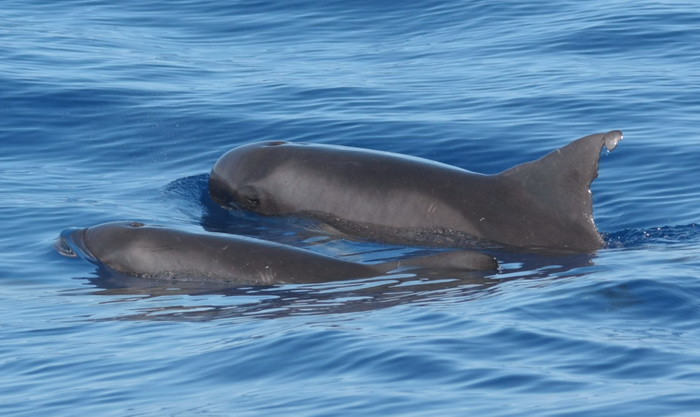
Two pygmy killer whales, August 19, 2010. Photo by Elisa Weiss. A new species for the trip, the 12th species of odontocete we’ve seen. Pygmy killer whales look very similar to melon-headed whales but can be distinguished by the clear demarcation between the darker dorsal cape and the lighter lateral pigmentation. Today we had two encounters with pygmy killer whales, and photo-identified 31 distinctive individuals. There is a small resident population of pygmy killer whales off the island and we recognize many of the individuals present today (including one first documented by Dan McSweeney on January 31, 1986). Pygmy killer whales are one of the least known species of delphinids in the world, and more is known of this species in Hawaii than anywhere else. For more information see our pygmy killer whale page.
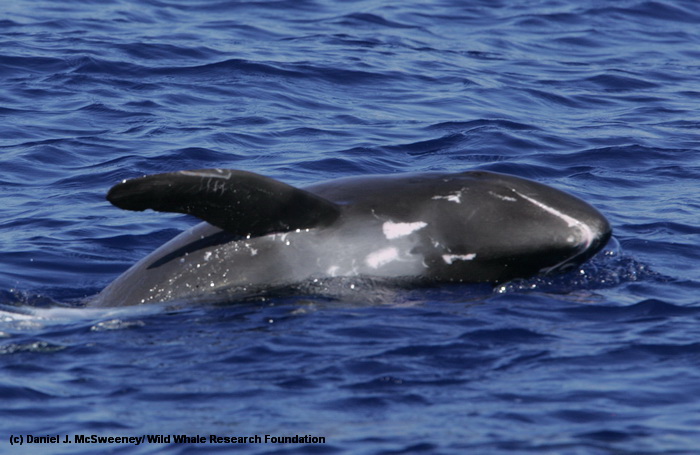
Pygmy killer whale rolling at surface, August 19, 2010. Photo by Dan McSweeney. The rounded tips to the flippers can also be used to distinguish pygmy killer whales from melon-headed whales.
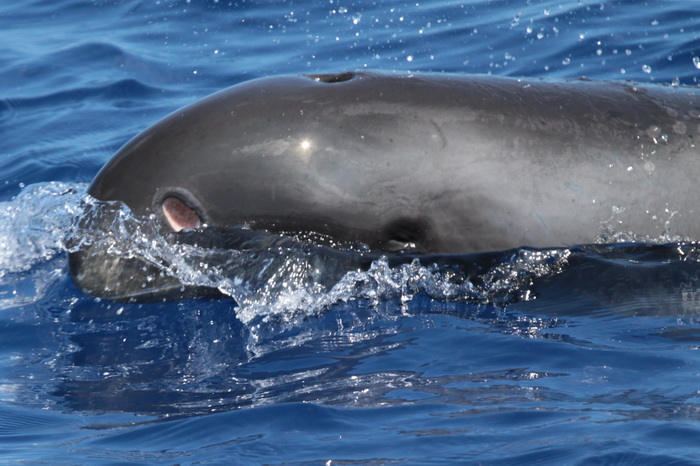
Pygmy killer whale with a recent wound from a cookie-cutter shark bite, August 19, 2010. Photo by Jessica Aschettino.
August 18th update
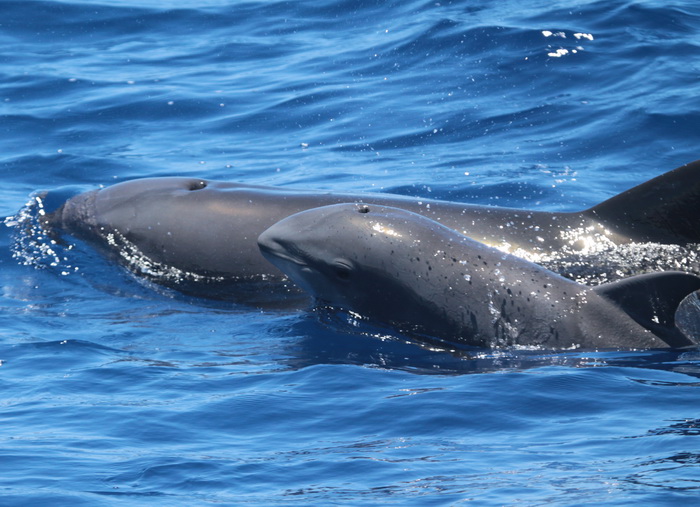
Melon-headed whale mother and infant off Kona, August 18, 2010. Photo by Jessica Aschettino.
Our second encounter with melon-headed whales for this trip, a group of about 190 individuals from the Hawaii-island resident population. We were able to obtain idntification photos of about 150 individuals and biopsy samples from 8 individuals for genetics and toxicology.
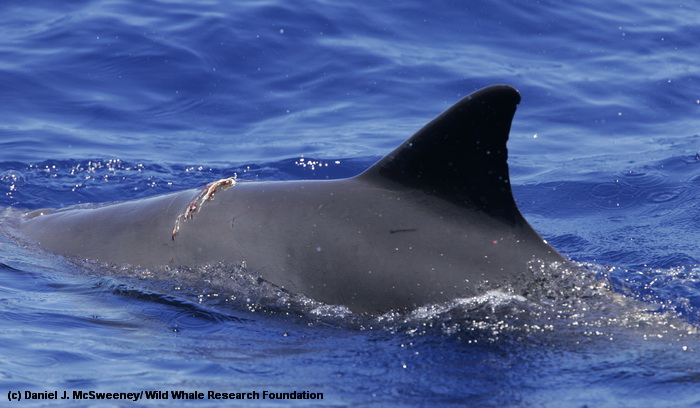
Melon-headed whale with possible shark bite wound, August 18, 2010. Photo by Dan McSweeney.
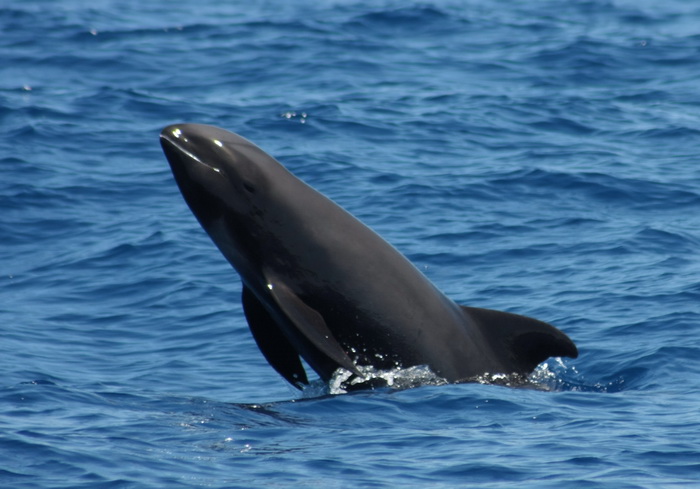
Melon-headed whale leaping, August 18, 2010. Photo by Elisa Weiss
August 16th update

False killer whale mother and infant, August 16, 2010. Photo by Dan McSweeney.
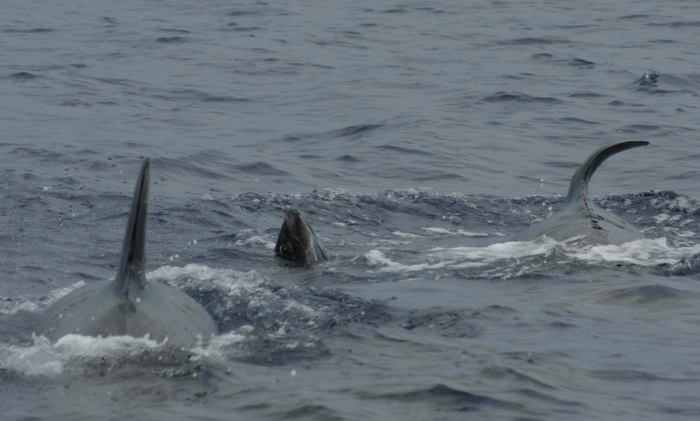
False killer whales and a fish, August 16, 2010. photo by Elisa Weiss.
August 14th update

An adult male false killer whale leaping August 14, 2010. False killer whales are sexually dimorphic (males are larger than females), but adult males can also be identified based on an extended overhang of the upper jaw, as in this individual. Photo by Dan McSweeney. The darker black spots on the head and behind the head are healed scars from cookie-cutter shark bites.
In 11 years of working in Hawai‘i on average we’ve encountered false killer whales once every 15 days of working on the water. In the last 25 days on the water we’ve encountered false killer whales on five occasions, including today. Another group from the resident (insular) population. We were able to photo-identify 25 to 30 individuals out of a group of about 35 and collect additional samples for genetics and toxicology.
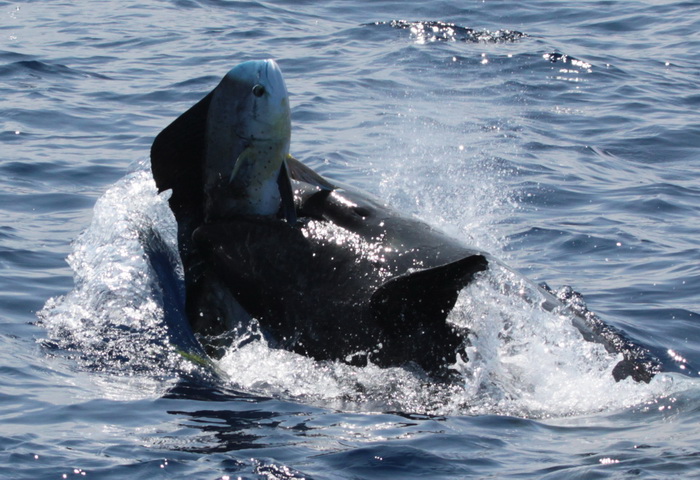
False killer whale with mahimahi, August 14, 2010. Photo by Jessica Aschettino. We documented five feeding occasions,including one mahimahi, one ahi (yellowfin tuna), one probable skipjack tuna, and two other unknown fish.

Fish part (air bladder and gills) left behind foraging false killer whales. Photo by Jessica Ashettino. We collect prey parts so they can be identified to species other based on morphology or genetically.
August 11th update
Over the last five days we’ve had a distant sighting of a new species for the trip, Cuvier’s beaked whales, as well as another sighting of Blainville’s beaked whales and a number of sightings of pilot whales and rough-toothed dolphins. Today we encountered another group of false killer whales from the resident population, and were able to obtain photo-IDs of at least 20 individuals and samples for genetic/pollutant studies from 7 individuals.

False killer whale with mahimahi, August 11, 2010. Photo by Dan McSweeney.

False killer whale, August 11, 2010. Photo by Jessica Aschettino. Note the two green dots on the base of the dorsal fin (first dot near the leading edge) – these green laser dots are 15 cm apart and we are using them to assess sexual dimorphism in false killer whales and other species.
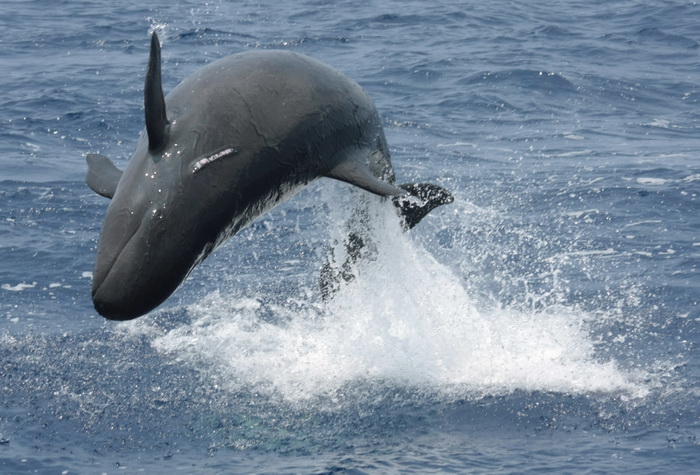
False killer whale leaping, August 11, 2010. Photo by Elisa Weiss.
August 6th update

False killer whale leaping, August 6, 2010. Photo by Elisa Weiss.
Another good day on the water, with encounters with five species including a group of about 20 false killer whales, including at least some from the group seen the day before.

Mahimahi seen during false killer whale encounter, August 6, 2010. Photo by Elisa Weiss.
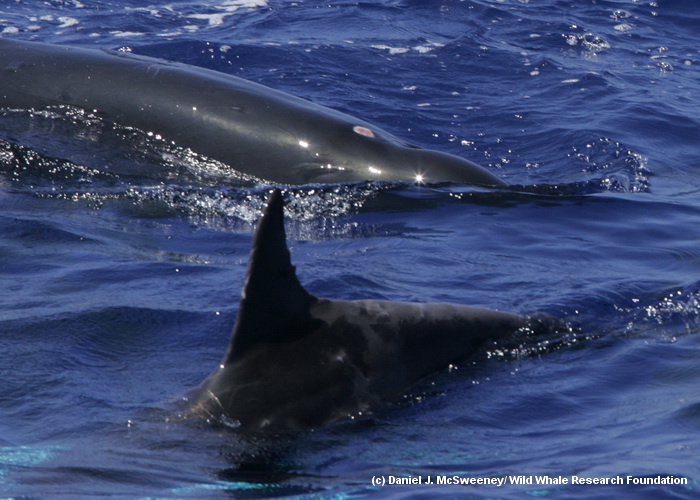
Rough-toothed dolphin (front) and false killer whale (back), August 6, 2010. Photo by Dan McSweeney. During the encounter with the false killer whales rough-toothed dolphins and bottlenose dolphins were seen trying to pick up fish parts left behind by the whales.
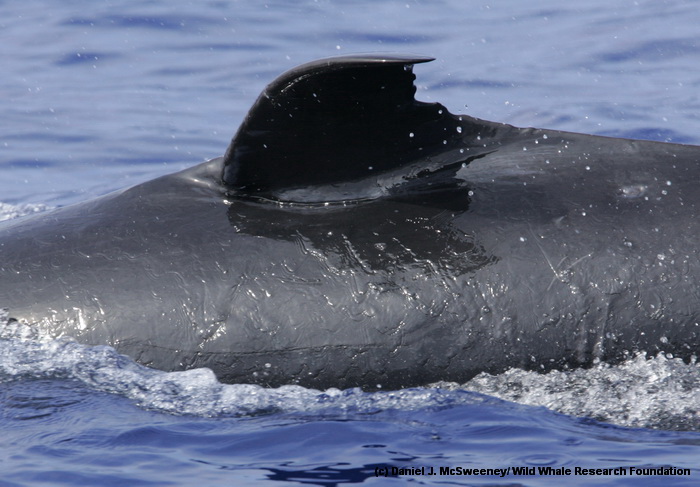
False killer whale with dorsal fin disfigurement, most likely caused by interaction with fishing gear. Photo by Dan McSweeney.
August 5th update
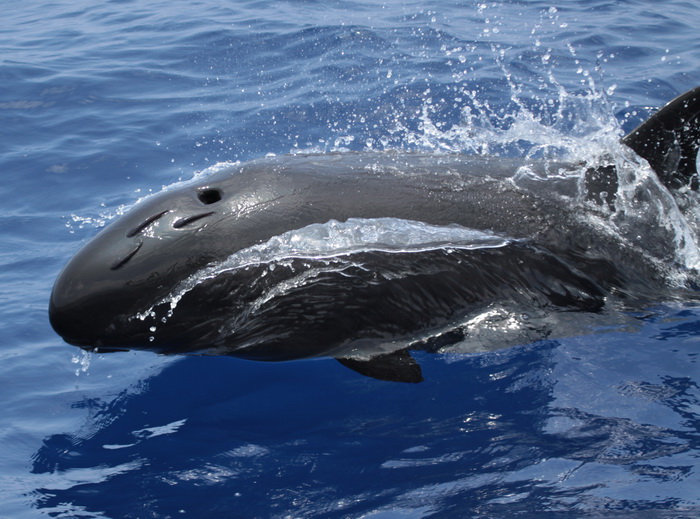
False killer whale with remoras, August 5, 2010. Photo by Elisa Weiss.
A good day on the water, a group of about 35 false killer whales from the insular (resident) population traveling south off Kona. We took over 4,000 photos, collected two prey samples, and made two acoustic recordings. The group was left off Kauna Point heading towards South Point.
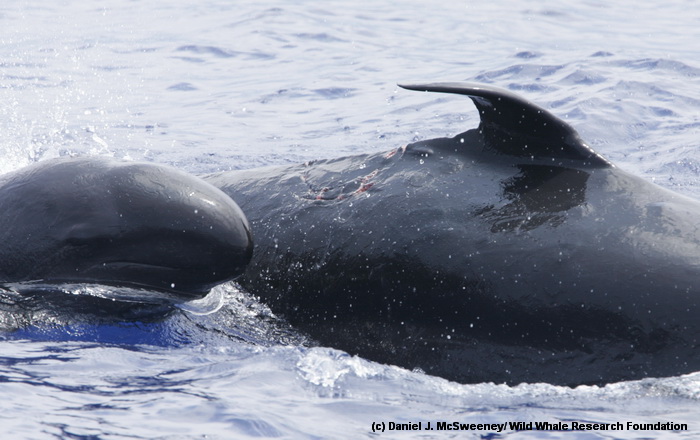
False killer whale with recent shark bite wound and a long-term injury to the dorsal fin, August 5, 2010. Photo by Dan McSweeney. This individual is HIPc127 in our catalog, first documented off Maui in March 2000 (with the bent dorsal fin), and seen several times since both off Maui and the island of Hawai‘i. The shark bite wound behind the dorsal fin is the first time we’ve documented evidence of an attack by a large shark on a false killer whale in Hawai‘i.
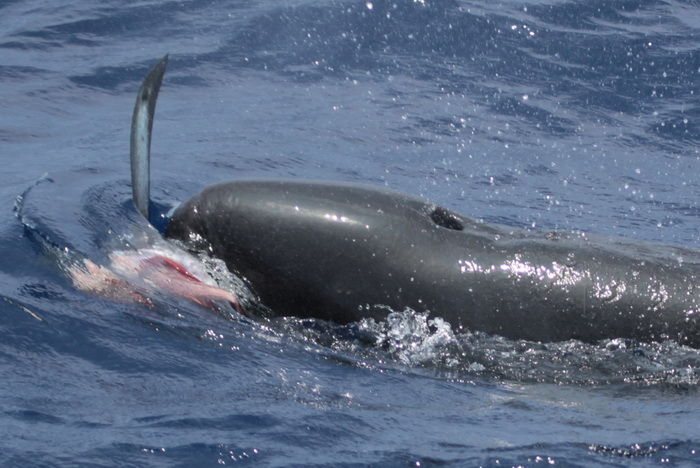
False killer whale carrying fish. Photo by Elisa Weiss.
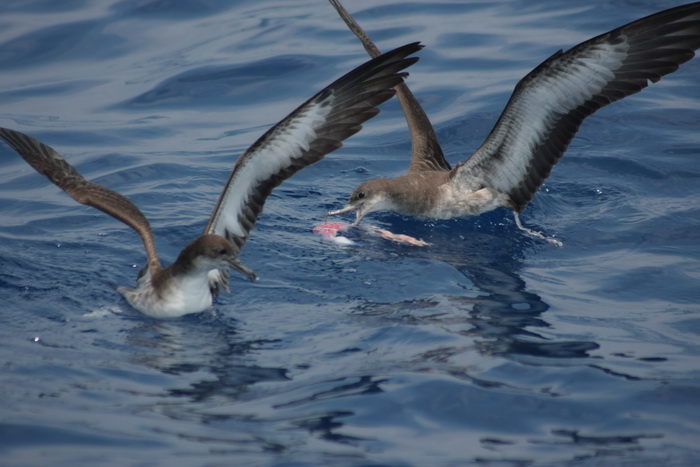
Wedge-tailed shearwaters scavenging fish left behind by foraging false killer whales. Photo by Cynthia Hankins.
August 1st update
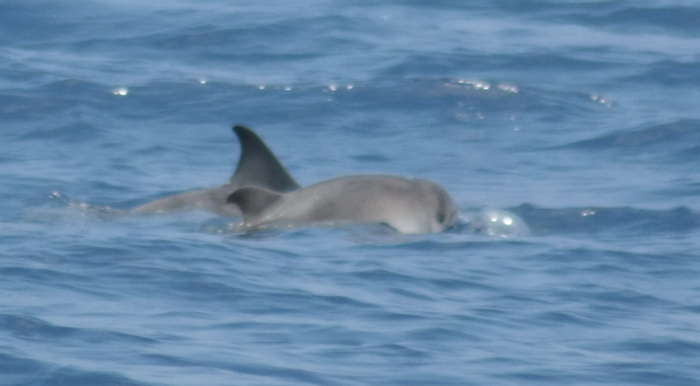
A dwarf sperm whale mother and calf, August 1st. Photo by Elisa Weiss.
On the water two of the last three days, with sightings of two groups of bottlenose dolphins (one of about 20 individuals), two groups of spotted dolphins, one group of short-finned pilot whales, and our second encounter with dwarf sperm whales for the trip. This was a group of between 5 and 7 individuals, at least three of which were distinctive and the photos have been added to our catalog. There is a small resident population of dwarf sperm whales off the island (see our dwarf sperm whale page for more infomation). None of the three distinctive individuals matched individuals in our catalog but sightings are infrequent and individuals acquire new marks regularly so it is possible one or more may already be in the catalog but are no longer recognizable.

A very distinctive dwarf sperm whale, August 1st. Photo by Jessica Aschettino. Note the uneven (blotchy) skin coloration, likely caused by the whale sloughing skin regularly, as also seen in sperm whales.
July 29th update

A rough-toothed dolphin, July 29th. Photo by Jessica Aschettino.
Six encounters today including three groups of short-finned pilot whales, a group of spotted dolphins, and two groups of rough-toothed dolphins, our 10th species for the trip. Individual identification photos will be added to our catalog for this species. For more information see our rough-toothed dolphin page.
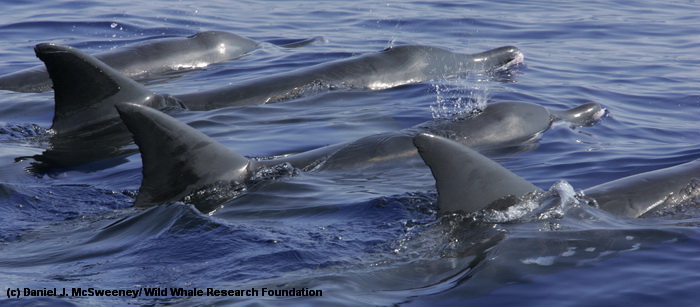
A group of rough-toothed dolphins surfacing synchronously, July 29th. Photo by Dan McSweeney.
July 28th update
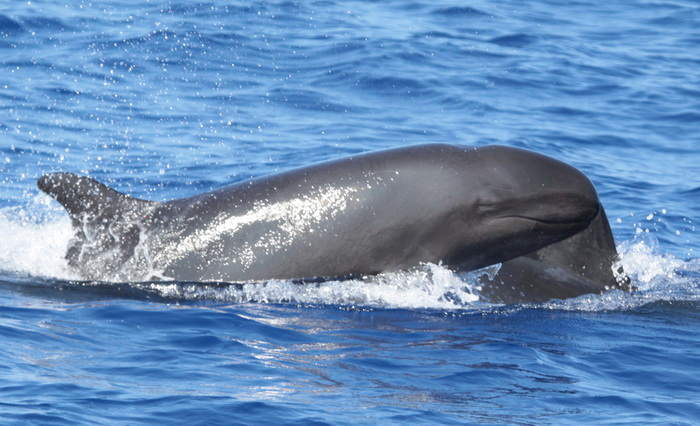
A false killer whale juvenile off the island of Hawai‘i, July 28th. Photo by Jessica Aschettino.
On our 11th day on the water for this trip we encountered our first group of false killer whales. Photos of six individuals taken through our catalog by Annie Gorgone revealed that all six have been seen multiple times around the main Hawaiian Islands, one as early as 1988, all part of the resident (“insular”) population. As well as identification photos we were able to obtain biopsy samples of three individuals which will be used for studies of population structure and toxin levels. For more information on this species or our work with false killer whales see our false killer whale page.
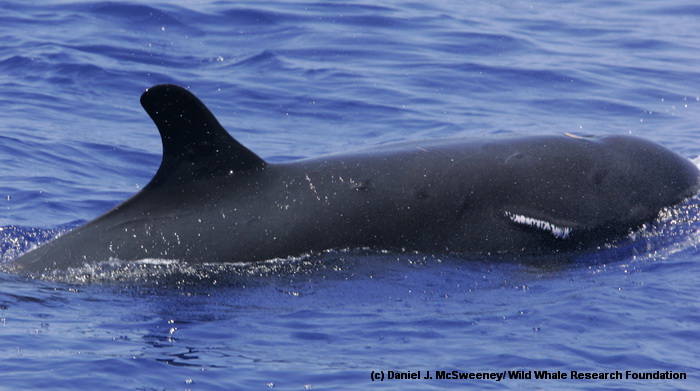
A false killer whale with an unusual scar behind the head. Photo by Dan McSweeney.

A well-marked false killer whale, HIPc120 in our catalog. This individual, an adult female first recorded with a calf in 1999, has been documented 17 previous times in nine different years, off the islands of O‘ahu, Maui and Hawai‘i. HIPc120 was last recorded off O‘ahu in October 2009 during a project being undertaken by the Pacific Islands Fisheries Science Center. Photo by Cynthia Hankins.
July 27th update

A Blainville’s beaked whale. Photo by Cynthia Hankins. We know this individual is an adult based on the large number of oval white scars (healed bites from cookie-cutter sharks) and can identify it as a female based on the lack of erupted teeth in the lower jaw. The light brown coloration on the side of the head and beak are probably diatoms.
A good day on the water today, encounters with pilot whales, bottlenose dolphins, and our 8th species for the trip, a group of four Blainville’s beaked whales, including two adult females, a juvenile, and an adult male. We were able to obtain good identification photos of all four individuals and one biopsy sample; so far we have been able to match three of the four individuals back to our catalog. One of the adult females was seen previously in 2005, the other was seen four times in 2008. The juvenile had been documented five times in 2007 and 2008. All are part of the population that is resident to the island of Hawai‘i. For more information see our beaked whale page.

Two Blainville’s beaked whales. Photo by Dan McSweeney.
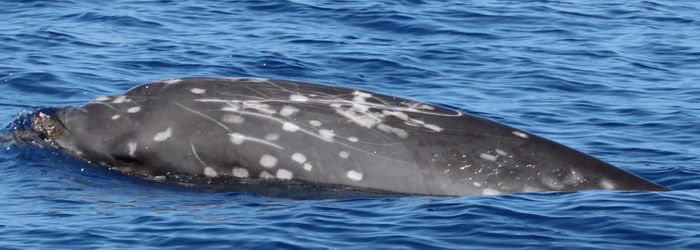
An adult male Blainville’s beaked whales. Photo by Jessica Aschettino. This individual can be identified as an adult male based on the large number of linear scars (caused by fighting with other adult males). One of the erupted teeth are visible just above the water line.

A short-finned pilot whale with some sort of white material streaming from the mouth. Photo by Cynthia Hankins.
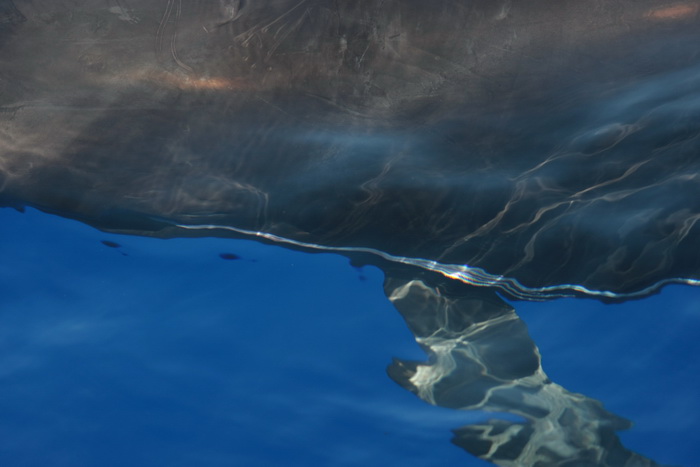
A close-up of the material streaming from the mouth of a short-finned pilot whale. Photo by Cynthia Hankins.
July 26th update

Short-finned pilot whale with tooth rakes on dorsal fin, probably from an interaction with another pilot whale. Photo by Dan McSweeney taken July 26.
Encounters today with the two most commonly-encountered species of toothed whales off the island of Hawai‘i, short-finned pilot whales and pantropical spotted dolphins.
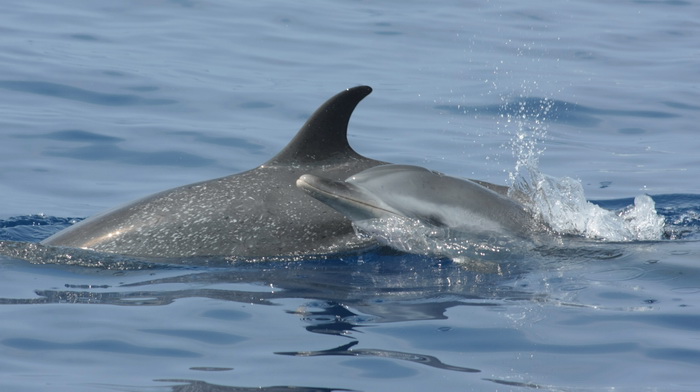
Pantropical spotted dolphin mother and calf, July 26th. Photo by Cynthia Hankins.
July 24th update
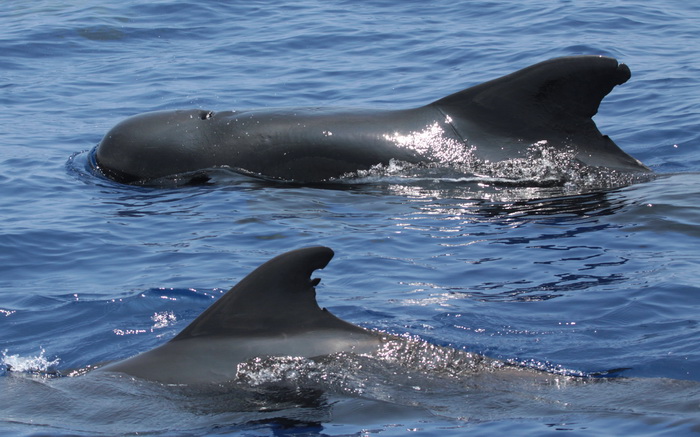
Short-finned pilot whales, July 24th. Photo by Jessica Aschettino.
After eight days on the water we’ve had 22 on-effort sightings (and several off-effort sightings of spinner dolphins at the mouth of Honokohau and Kawaihae Harbors) of seven species: 9 groups of short-finned pilot whales, 4 groups each of bottlenose dolphins and pantropical spotted dolphins, and a single group each of sperm whales, dwarf sperm whales, melon-headed whales, spinner dolphins, and an unidentified dolphin. A good start to the project. Some additional photos below from July 23rd.

Bottlenose dolphin, July 23rd. Photo by Cynthia Hankins

Bottlenose dolphins, July 23rd. Photo by Jessica Aschettino.
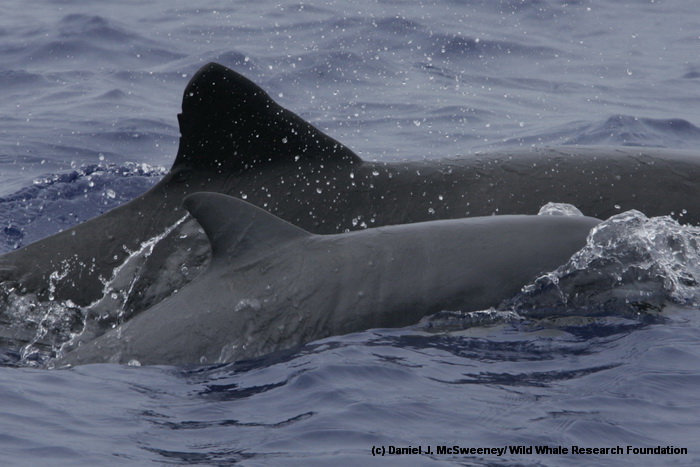
Melon-headed whale mother and newborn, July 23rd. Photo by Dan McSweeney. Note the vertical lines on the infant, termed “fetal folds”.
July 23rd update

A melon-headed whale high-speed traveling. Photo by Jessica Aschettino. Note the dark facial “mask” and the diffuse demarcation between the darker grey saddle and lighter gray lateral pigmentation, both characteristic of melon-headed whales.
A good day on the water, seven sightings of four species including our 7th species for the trip, a group of about 175 melon-headed whales. This group is part of the resident population, that appears to live just off the west side of the island of Hawai‘i (see our melon-headed whale web page for more information on this population). We were able to collect seven biopsy samples for genetics and toxicology and also took ~2,600 photos to identify individuals.
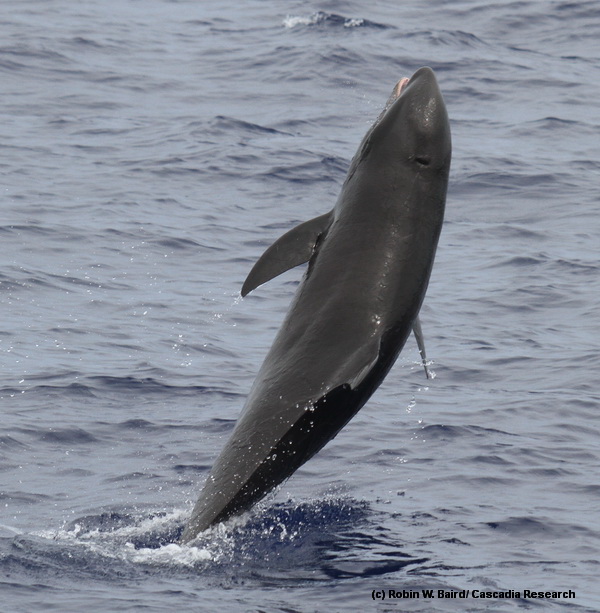
A melon-headed whale leaping. Note the pointed tips to the flippers and the pointed head when viewed from above. Photo by Robin Baird
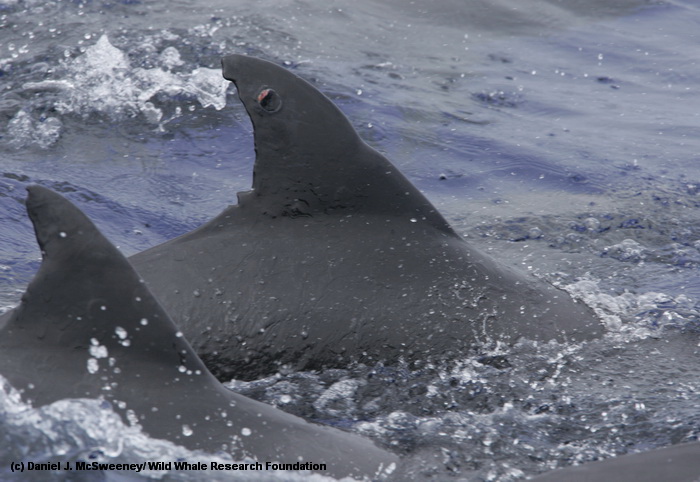
Two distinctive melon-headed whales. The individual on the right has a wound caused by a bite from a cookie-cutter shark. Photo by Dan McSweeney.
July 22nd update
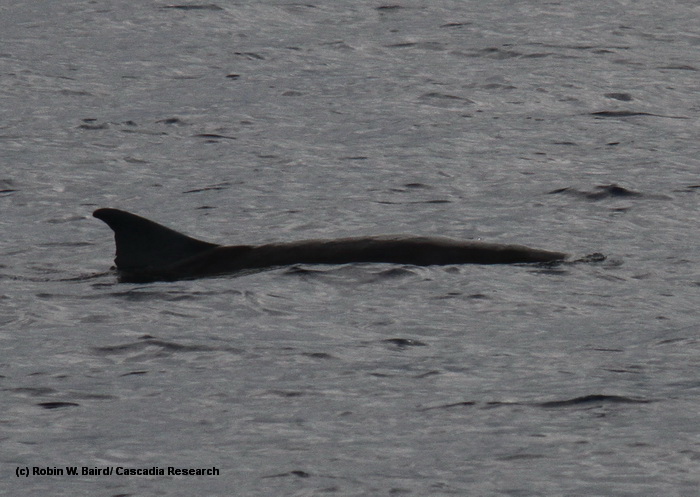
An adult dwarf sperm whale, July 22nd. Photo by Robin Baird.
Our 6th day on the water and we encountered our 6th species for the trip, a pair of dwarf sperm whales. We were able to get good photos of both individuals (one distinctive adult shown above and a juvenile) and also collected a skin sample from the adult for genetic studies. Later in the day we encountered two groups of pilot whales and also collected our fourth squid for the trip.
July 21st update

Sperm whale mother and calf, July 21st. Photo by Robin Baird
Our 5th day on the water this trip and we encountered our 5th species, a group of about 15 sperm whales. The group contained one newborn individual and two calves probably less than a year of age. We were able to collect one sloughed skin sample and dorsal fin photos of most of the whales present. We also encountered two groups of pilot whales, two bottlenose dolphins, and collected our third squid for the trip.
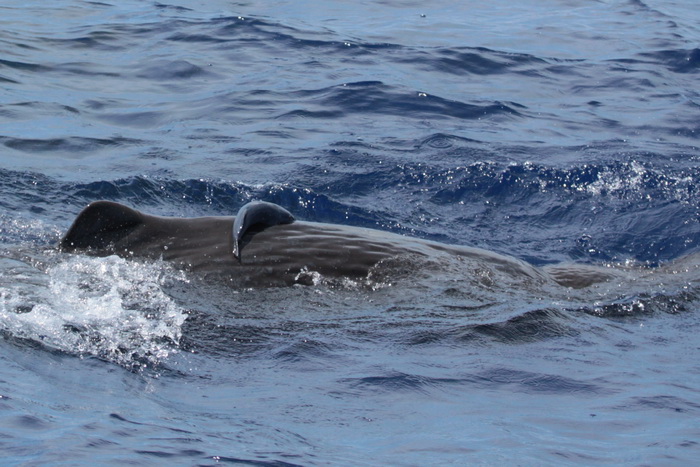
Sperm whale calf with remora. Photo by Jessica Aschettino.
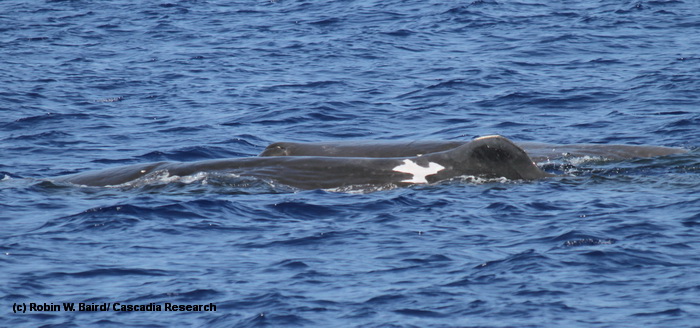
Two adult female sized sperm whales, July 21st. Photo by Robin Baird. The closest individual has a large very distinctive scar in front of the fin that can be used to recognize this individual in the future.
July 20th update
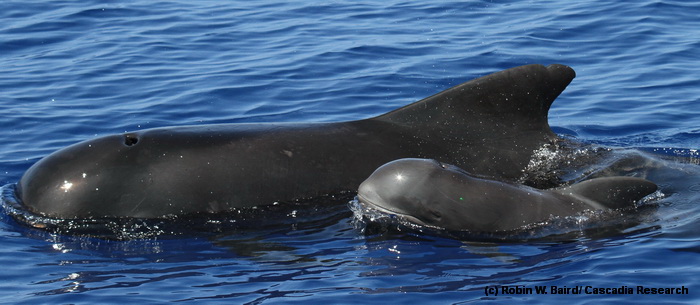
Short-finned pilot whale mother and newborn calf, July 20, 2010. Photo by Robin Baird.
After another windy day on the water out of Kawaihae yesterday (with one sighting of spotted dolphins and one sighting of bottlenose dolphins) we decided to move the boat back down to Honokohau Harbor. Today we had MUCH calmer seas, and although we only had two sightings (including one group of spotted dolphins) we had our first sighting of pilot whales for the trip, a group of about 55 individuals.
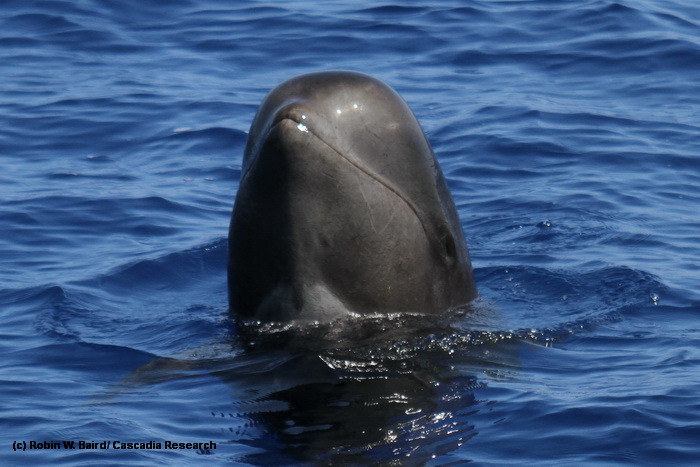
Short-finned pilot whale spyhopping, July 20, 2010. Photo by Robin Baird. We also take spyhopping photos in order to look for scars on the mouthline that may be indicative of fishery interactions.
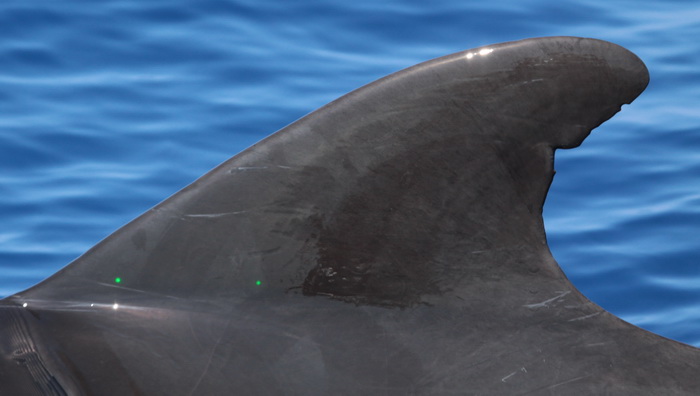
Short-finned pilot whale with green dots from a laser photogrammetry system, July 20, 2010. Photo by Jessica Aschettino. We have started using a laser photogrammetry system (the two green dots visible on this whale are 15 cm apart) to measure the length and height of dorsal fins to assess sexual dimorphism in pilot whales and other species.

Squid collected July 20, 2010. Photo by Robin Baird. We also collected two squid today, both found floating at the surface. These squid will go to Bill Walker at the National Marine Mammal Laboratory for identification and for genetic and stable isotope studies.
July 18th update
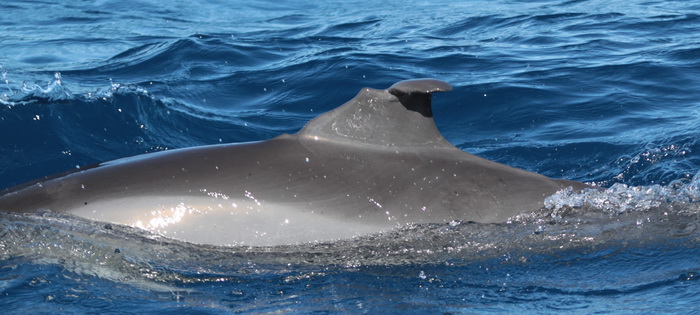
Spinner dolphin with damaged dorsal fin. Photo by Jessica Aschettino.
Our second day on the water looking for melon-headed whales and false killer whales. Today we saw spinner and pantropical spotted dolphins.

Spinner dolphin. Photo by Karin Forney.
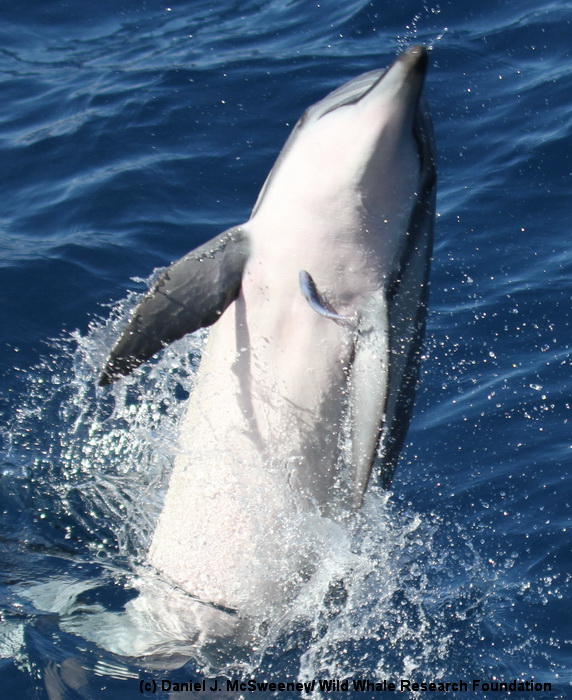
Spinner dolphin spinning to get rid of a remora. Photo by Dan McSweeney.
July 17th update
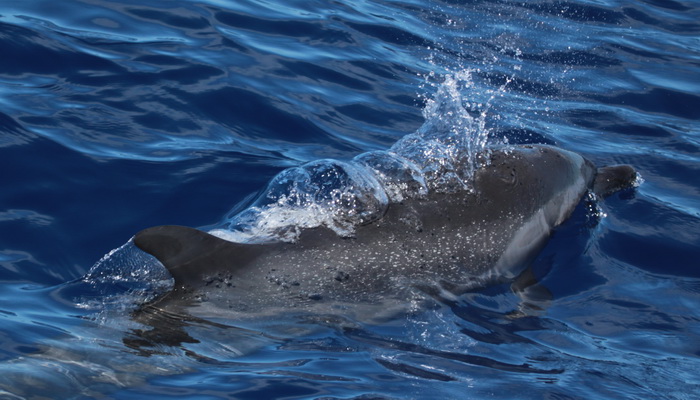
Pantropical spotted dolphin, July 17, 2010. Photo by Jessica Aschettino.
Our first day on the water based out of Kawaihae since May 2003. Although the winds picked up early we encountered two species of cetaceans, a group of spinner dolphins close to the harbor and a group of pantropical spotted dolphins to the north.
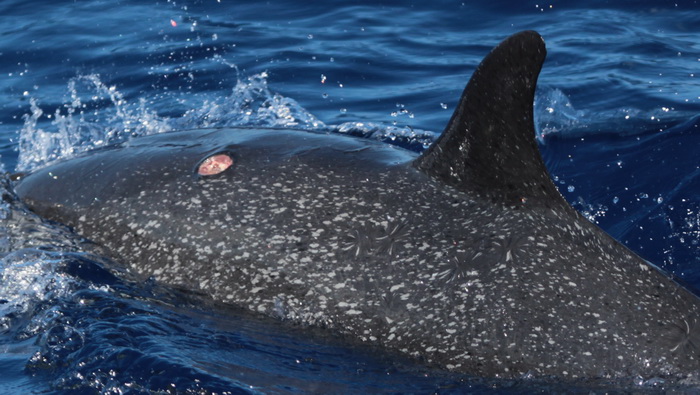
An adult pantropical spotted dolphin with a fresh bite from a cookie-cutter shark. Photo by Jessica Aschettino. Below the dorsal fin there are several areas where old cookie-cutter shark bite wounds have completely healed, and as they have healed the white spots on the edges of the bites appear to have been stretched inwards as the wound healed.
Photos on this page taken under NMFS Scientific Research Permits (Nos. 731-1774 and 774-1714). All photos are copyrighted and should not be used without permission.